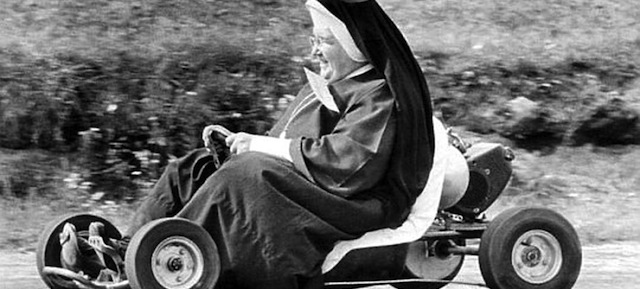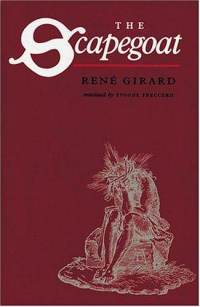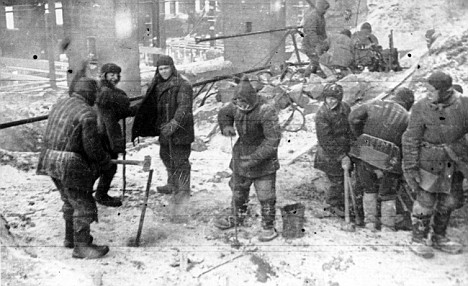
 Alejandro and Maria Martinelly of Prince William County, Virginia, knew their son’s affliction all too well, and so they hid the car keys from him. The ruse was effective in keeping him from his third conviction – until one night in August 2010. Fresh into his latest bender, young Carlos A. Martinelly-Montano dug the keys out of his parents’ closet, fired up their Subaru Outback, and went on a joyride. Anyone who has been in debt to, or had a loved one in debt to the rapacious creditor that hounded 23-year-old Carlos knows all too well that no amount of trickery could have matched the ferocity of the young man’s desire to find the car keys.
Alejandro and Maria Martinelly of Prince William County, Virginia, knew their son’s affliction all too well, and so they hid the car keys from him. The ruse was effective in keeping him from his third conviction – until one night in August 2010. Fresh into his latest bender, young Carlos A. Martinelly-Montano dug the keys out of his parents’ closet, fired up their Subaru Outback, and went on a joyride. Anyone who has been in debt to, or had a loved one in debt to the rapacious creditor that hounded 23-year-old Carlos knows all too well that no amount of trickery could have matched the ferocity of the young man’s desire to find the car keys.
Drunk driving accidents yield strange results. It seems as if the driver always survives, and the sober victim, who was wearing a seat-belt, dies. Yet perhaps this result is less strange, and more in keeping with life, than it appears: from the point of view of the victims—say, for example, three nuns driving from Richmond to little Bristow, Virginia, to a convent retreat—having one’s driving interrupted by the cannonball smash of a ton of hurling and careening steel on wheels is, after all, a most irrational and unreasoned event. So perhaps it is more appropriate, in the perverse manner proper in this world, that only the nun in the backseat of the little Toyota, protected by the gentle barrier of a front seat—in this case 66-year-old Sister Denise Mosier—died.
Eighteen or so months have passed. Another sister, Charlotte Lange, spent several months in the hospital and her curly hair has turned straight. And she is, strange to say, grateful for her experience.
“I think I even might be a nicer person,” said Lange, a member of the Benedictine Sisters of Virginia, whose home base is in Bristow. “Not that I want to go through it again . . . but it happened. I think I’m all the better for it.”
It is not supposed to be this way. Charlotte was supposed to become bitter, resentful, and vengeful. She was not supposed to spend her days comforting patients in one of the very hospitals in which she resided for those months of her recovery. If she is a normal human being, she is supposed to feel entitled to something better.
Notable to me was young Carlos’s immigration status at the time of the accident. Carlos arrived in the United States from Bolivia at age eight with his parents. He had received two DUI convictions in the intervening years and, adding to the senselessness of the accident, was scheduled to appear at a deportation hearing weeks after the date of the accident. His case had dragged on for several months longer than the average proceeding of its kind. He and his family were granted work permits while their cases were processed, but those permits did not legalize their residency.
 Carlos’s immigration status made an easy target for those seeking to cast blame. And, of course, activists in favor of greater restrictions on illegal immigration howled at the accident as proof of the troubles caused by illegal immigrants and the laxity of immigration controls. Now, as a political issue, illegal immigration is a tricky one; neither major political party in this country has quite captured my own textured, reasoned, and exceptionally thought-out position on the issue (and who could?). But, needless to say, Carlos’s immigration status is collateral to his alcoholism. Where are the voices of the pro- and anti-immigration activists after the thousands of drunk driving deaths caused by naturalized American citizens? No matter, said Prince William County official Corey Stewart, who accused the political powers-that-were of having “blood on their hands” for failing to adequately enforce immigration controls.
Carlos’s immigration status made an easy target for those seeking to cast blame. And, of course, activists in favor of greater restrictions on illegal immigration howled at the accident as proof of the troubles caused by illegal immigrants and the laxity of immigration controls. Now, as a political issue, illegal immigration is a tricky one; neither major political party in this country has quite captured my own textured, reasoned, and exceptionally thought-out position on the issue (and who could?). But, needless to say, Carlos’s immigration status is collateral to his alcoholism. Where are the voices of the pro- and anti-immigration activists after the thousands of drunk driving deaths caused by naturalized American citizens? No matter, said Prince William County official Corey Stewart, who accused the political powers-that-were of having “blood on their hands” for failing to adequately enforce immigration controls.
Stewart’s comment demonstrates the scapegoat mechanism at work (either that, or a conscious attempt to make political hay out of a tragedy unrelated to the issue du jour). Rene Girard teaches us that man’s impulse in the face of crisis is an essentially violent one; rather than face the terrible specter of a tragedy that has no explanation beyond the simple nastiness of this world, man seeks out an object of blame and heaps violence upon him. That violence deludes the accuser; it hypnotizes him into believing that the terrors of this world are, perhaps in some small way, within his control.
A good scapegoat, like Carlos, supplies a “delicately balanced mechanism of associations”: Carlos, as a fellow man and law-breaker, is a plausible object of blame and a “good conductor” of the group’s violent impulses; and his main source of difference—his status as an immigrant, and an illegal one at that—distinguishes him from the group and makes him incapable of self-defense. So begins the piling on.
That is not to say that the scapegoat is somehow innocent; here, for example, Carlos got no help for his addiction, broke the law, and caused immense suffering. But Girard urges us into “demythify” the group’s stated rationale for the blame he heaps upon the scapegoat, to approach it with skepticism, to observe the ulterior motive underlying the persecution and parading as a quest for justice.
 Girard joined his mother in the Catholic Church because he concluded that the Christian Gospels offered the fullest demythification of the scapegoating ruse. According to Girard, the crucifixion of Christ was history’s great demythifying event, and the Gospels’ history’s great demythifying texts, revealing as they do the blaming of an entirely blameless scapegoat and, in so doing, disclosing the violence upon which every human community is built, and from which every human community requires rescue.
Girard joined his mother in the Catholic Church because he concluded that the Christian Gospels offered the fullest demythification of the scapegoating ruse. According to Girard, the crucifixion of Christ was history’s great demythifying event, and the Gospels’ history’s great demythifying texts, revealing as they do the blaming of an entirely blameless scapegoat and, in so doing, disclosing the violence upon which every human community is built, and from which every human community requires rescue.
All of us are at various times scapegoat, accuser, and everything in between. But wherever we fall on that spectrum at any given time, the seed from which the scapegoating weed blooms is the illusion of difference between the accuser and the accused. What happens when that difference is wiped away? What happens when accuser sees herself as worthy of accusation?
[F]or the nuns, the focus has always been on forgiveness rather than punishment. Martinelly-Montano should face consequences, they say. The sisters never liked the politicization of the case and the condemnation of the young man as a murderer for what they see as a terrible accident driven by a sickness with alcohol.
“The way we look at it, it was an accident,” said Lupton, who now lives at the Bristow monastery. “He didn’t plan to get up that morning and do that. He will never turn around if he doesn’t get out and face freedom.”
Or as Lange put it: “But for the grace of God, I could be an alcoholic, and it could have been me behind that wheel.”
Sister Lange demythified more deeply. As the enlightened among us demythify the chronicler’s stated justification for the mob’s violence, Sister Lange demythifies the greatest and most dominant myth in all of the world and in all of history: the myth of her own entitlement. This is the beginning of wisdom. I am reminded of Solzhenitsyn’s Gulag ephiphany, in which he:
…lay there on rotting prison straw that I sensed within myself the first stirrings of good. Gradually it was disclosed to me that the line separating good and evil passes not through states, nor between classes, nor between political parties either, but right through every human heart, and through all human hearts. This line shifts. Inside us, it oscillates with the years. Even within hearts overwhelmed by evil, one small bridgehead of good is retained; and even in the best of all hearts, there remains a small corner of evil.
If only there were evil people somewhere insidiously committing evil deeds, and it were necessary only to separate them from the rest of us and destroy them. But the line dividing good and evil cuts through the heart of every human being. And who is willing to destroy a piece of his own heart?”
The demythification of one’s own goodness is the difference between war and peace, between resentment and grace, between tribe and Church. You can practice or “be intentional” about this conviction all you want, but, on the heels of an unexpected terror that killed a friend and turned your curly hair straight, it becomes clear that this is a divine act. Connie Ruth Lupton, the third nun injured in the accident, described Lange’s ability to forgive Carlos as “natural to her.” But that is not the whole story.
God, help us be like the nuns.

COMMENTS
7 responses to “God, Help Us Be Like the Nuns: Drunk Driving, Scapegoats and Gulag Wisdom”
Leave a Reply















Great piece! If you haven’t already, check out some of James Alison’s writings. He takes Girard’s insights on mimesis and scapegoating to another theological level. Very powerful stuff.
I had my second “Ah-ha!” moment this morning while reading this article. Thank you sir!
Nicky Gumbal used to make use of that brilliant Solzhenitsyn quote about the human heart in one of the early Alpha talks. I’ve been looking for it ever since I first heard it, but not too diligently, and am so glad to finally come across it in full here this morning. Thanks Mbird for this great piece. It really highlights some of the ways that being a Christian fundamentally changes the way one views the world. God bless those nuns. JZ